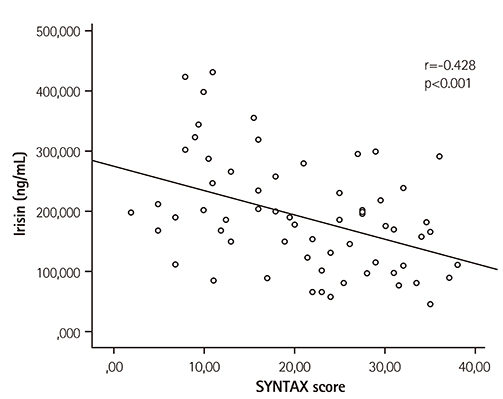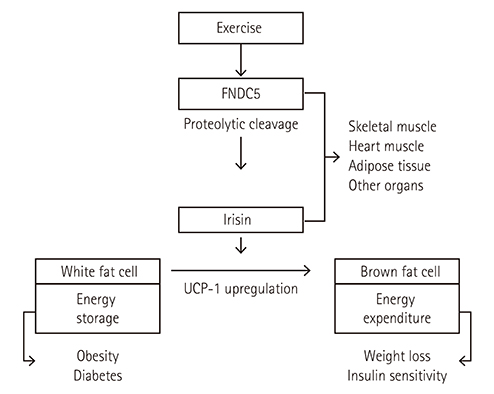Korean Circ J.
2017 Jan;47(1):44-49. 10.4070/kcj.2016.0079.
Serum Irisin Level Can Predict the Severity of Coronary Artery Disease in Patients with Stable Angina
- Affiliations
-
- 1Dışkapı Yıldırım Beyazıt Training and Research Hospital, Cardiology Clinic, Ankara, Turkey.
- 2Türkiye Yüksek Ihtisas Training and Research Hospital, Cardiology Clinic, Ankara, Turkey. cagriyayla@gmail.com
- KMID: 2365281
- DOI: http://doi.org/10.4070/kcj.2016.0079
Abstract
- BACKGROUND AND OBJECTIVES
The recently discovered myokine irisin has a proposed role in adipose tissue metabolism. The aim of this study was to evaluate the relationship between serum irisin level and the coronary artery severity in patients with stable coronary artery disease (CAD).
SUBJECTS AND METHODS
Sixty-three patients who underwent coronary angiography (CA) diagnosed with stable CAD and twenty-six patients with normal coronary artery (NCA) were enrolled in the study. Stable CAD patients were divided into two groups as high synergy between percutaneous coronary intervention with taxus and cardiac surgery (SYNTAX) score (≥23) and lower SYNTAX score (<23). Serum irisin level measurement was carried out using human irisin colorimetric enzyme-linked immunosorbent assay (ELISA) commercial kit (AG-45A-0046EK-KI01, Adipogen, San Diego, CA, USA) as recommended by the manufacturer's protocol.
RESULTS
The patients with stable CAD with a higher SYNTAX score (score ≥23) had significantly lower serum irisin levels (127.91±55.38 ng/mL), as compared the patients with a low SYNTAX score (score <23) (224.69±92.99 ng/mL) and control group (299.54±123.20 ng/mL). Irisin levels showed significant differences between all groups (p<0.001).
CONCLUSION
Serum irisin level is an independent predictor of coronary artery severity in patients with stable CAD.
Keyword
MeSH Terms
Figure
Cited by 1 articles
-
Can Pre-analytical Mistake Bearing Irisin Concentrations Be an Indicator of Coronary Artery Disease?
Suna Aydin
Korean Circ J. 2018;48(1):94-95. doi: 10.4070/kcj.2017.0060.
Reference
-
1. Pedersen BK, Febbraio MA. Muscles, exercise and obesity: skeletal muscle as a secretory organ. Nat Rev Endocrinol. 2012; 8:457–465.2. Pedersen BK, Akerstrom TC, Nielsen AR, Fischer CP. Role of myokines in exercise and metabolism. J Appl Physiol (1985). 2007; 103:1093–1098.3. Bostrom P, Wu J, Jedrychowski MP, et al. A PGC1-alpha-dependent myokine that drives brown-fat-like development of white fat and thermogenesis. Nature. 2012; 481:463–468.4. Huh JY, Panagiotou G, Mougios V, et al. FNDC5 and irisin in humans: I. Predictors of circulating concentrations in serum and plasma and II. mRNA expression and circulating concentrations in response to weight loss and exercise. Metabolism. 2012; 61:1725–1738.5. Vamvini MT, Aronis KN, Panagiotou G, et al. Irisin mRNA and circulating levels in relation to other myokines in healthy and morbidly obese humans. Eur J Endocrinol. 2013; 169:829–834.6. Moreno-Navarrete JM, Ortega F, Serrano M, et al. Irisin is expressed and produced by human muscle and adipose tissue in association with obesity and insulin resistance. J Clin Endocrinol Metab. 2013; 98:E769–E778.7. Crujeiras AB, Pardo M, Arturo RR, et al. Longitudinal variation of circulating irisin after an energy restriction-induced weight loss and following weight regain in obese men and women. Am J Hum Biol. 2014; 26:198–207.8. Park KH, Zaichenko L, Brinkoetter M, et al. Circulating irisin in relation to insulin resistance and the metabolic syndrome. J Clin Endocrinol Metab. 2013; 98:4899–4907.9. Stengel A, Hofmann T, Goebel-Stengel M, Elbelt U, Kobelt P, Klapp BF. Circulating levels of irisin in patients with anorexia nervosa and different stages of obesity--correlation with body mass index. Peptides. 2013; 39:125–130.10. Liu JJ, Liu S, Wong MD, et al. Relationship between circulating irisin, renal function and body composition in type 2 diabetes. J Diabetes Complications. 2014; 28:208–213.11. Choi YK, Kim MK, Bae KH, et al. Serum irisin levels in new-onset type 2 diabetes. Diabetes Res Clin Pract. 2013; 100:96–101.12. Sesti G, Andreozzi F, Fiorentino TV, et al. High circulating irisin levels are associated with insulin resistance and vascular atherosclerosis in a cohort of nondiabetic adult subjects. Acta Diabetol. 2014; 51:705–713.13. Farooq V, Vergouwe Y, Raber L, et al. Combined anatomical and clinical factors for the long-term risk stratification of patients undergoing percutaneous coronary intervention: the Logistic Clinical SYNTAX score. Eur Heart J. 2012; 33:3098–3104.14. Garg S, Sarno G, Serruys PW, et al. Prediction of 1-year clinical outcomes using the SYNTAX score in patients with acute ST-segment elevation myocardial infarction undergoing primary percutaneous coronary intervention: a substudy of the STRATEGY (Single High-Dose Bolus Tirofiban and Sirolimus-Eluting Stent Versus Abciximab and Bare-Metal Stent in Acute Myocardial Infarction) and MULTISTRATEGY (Multicenter Evaluation of Single High-Dose Bolus Tirofiban Versus Abciximab With Sirolimus-Eluting Stent or Bare-Metal Stent in Acute Myocardial Infarction Study) trials. JACC Cardiovasc Interv. 2011; 4:66–75.15. Matthews DR, Hosker JP, Rudenski AS, Naylor BA, Treacher DF, Turner RC. Homeostasis model assessment: insulin resistance and beta-cell function from fasting plasma glucose and insulin concentrations in man. Diabetologia. 1985; 28:412–419.16. Kuloglu T, Aydin S, Eren MN, et al. Irisin: a potentially candidate marker for myocardial infarction. Peptides. 2014; 55:85–91.17. Aydin S, Aydin S, Kuloglu T, et al. Alterations of irisin concentrations in saliva and serum of obese and normal-weight subjects, before and after 45 min of a Turkish bath or running. Peptides. 2013; 50:13–18.18. Liu JJ, Wong MD, Toy WC, et al. Lower circulating irisin is associated with type 2 diabetes mellitus. J Diabetes Complications. 2013; 27:365–369.19. Polyzos SA, Kountouras J, Anastasilakis AD, Margouta A, Mantzoros CS. Association between circulating irisin and homocysteine in patients with nonalcoholic fatty liver disease. Endocrine. 2015; 49:560–562.20. Moreno M, Moreno-Navarrete JM, Serrano M, et al. Circulating irisin levels are positively associated with metabolic risk factors in sedentary subjects. PLoS One. 2015; 10:e0124100.21. Park SE, Park CY, Sweeney G. Biomarkers of insulin sensitivity and insulin resistance: Past, present and future. Crit Rev Clin Lab Sci. 2015; 52:180–190.22. Aronis KN, Moreno M, Polyzos SA, et al. Circulating irisin levels and coronary heart disease: association with future acute coronary syndrome and major adverse cardiovascular events. Int J Obes (Lond). 2015; 39:156–161.23. Emanuele E, Minoretti P, Pareja-Galeano H, Sanchis-Gomar F, Garatachea N, Lucia A. Serum irisin levels, precocious myocardial infarction, and healthy exceptional longevity. Am J Med. 2014; 127:888–890.24. Lu J, Xiang G, Liu M, Mei W, Xiang L, Dong J. Irisin protects against endothelial injury and ameliorates atherosclerosis in apolipoprotein E-Null diabetic mice. Atherosclerosis. 2015; 243:438–448.25. Löffler D, Müller U, Scheuermann K, et al. Serum irisin levels are regulated by acute strenuous exercise. J Clin Endocrinol Metab. 2015; 100:1289–1299.
- Full Text Links
- Actions
-
Cited
- CITED
-
- Close
- Share
- Similar articles
-
- Elevated hs-CRP in Patients with Stable Angina Pectoris
- Role of inflammation in stable angina patients without hypercholesterolemia
- Evaluation of Myocardial Ischemia Using Coronary Computed Tomography Angiography in Patients with Stable Angina
- Medical Management of Coronary Artery Disease
- The Experience of Percutaneous Transluminal Coronary Angioplasty (PTCA) on the 25 Patients with Coronary Artery Disease



